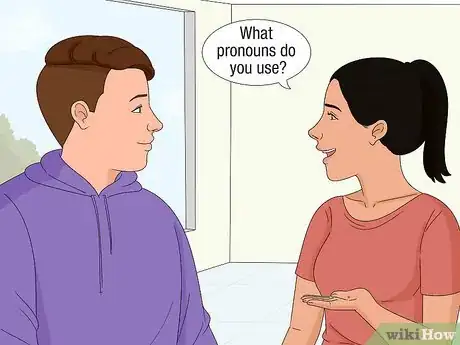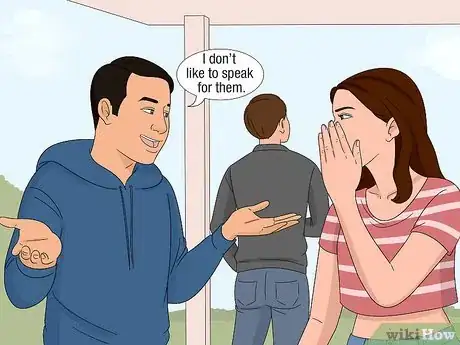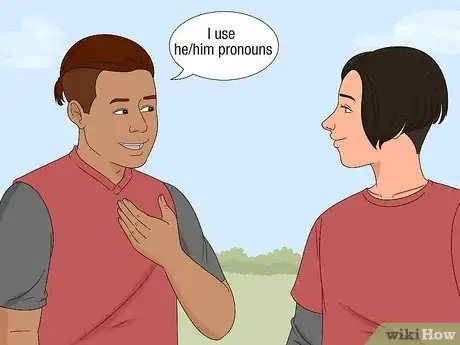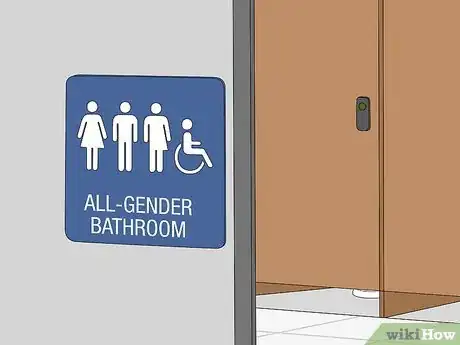This article was co-authored by Marissa Floro, PhD and by wikiHow staff writer, Kira Jan. Dr. Marissa Floro, Ph.D. is a Psychologist and Instructor at Stanford University’s Weiland Health Initiative and adjunct faculty at the University of San Francisco. Dr. Floro received her Ph.D. in Counseling Psychology from Loyola University Chicago, focusing on the intersections of race, attraction, and gender. Dr. Floro’s continued clinical, teaching, and advocacy work focuses on sexual and gender diversity, racial identity and belonging, and liberation from oppressive systems and structures.
There are 12 references cited in this article, which can be found at the bottom of the page.
This article has been viewed 104,028 times.
When your friend experiences gender dysphoria, you might not understand exactly what they’re going through if you’re a cisgender person. That’s totally okay—you can still support them, and you can take steps to educate yourself about their experience as you go. Gender dysphoria refers to a feeling of distress when a person’s gender identity differs from the sex they were assigned at birth.[1] Not all trans or nonbinary people experience gender dysphoria, but if your friend is struggling, you can make a positive difference in their life.
Here are 11 ways you can be a good ally to a friend who is experiencing gender dysphoria.
Steps
Expert Q&A
-
QuestionHow do you help someone with gender dysphoria?
 Marissa Floro, PhDDr. Marissa Floro, Ph.D. is a Psychologist and Instructor at Stanford University’s Weiland Health Initiative and adjunct faculty at the University of San Francisco. Dr. Floro received her Ph.D. in Counseling Psychology from Loyola University Chicago, focusing on the intersections of race, attraction, and gender. Dr. Floro’s continued clinical, teaching, and advocacy work focuses on sexual and gender diversity, racial identity and belonging, and liberation from oppressive systems and structures.
Marissa Floro, PhDDr. Marissa Floro, Ph.D. is a Psychologist and Instructor at Stanford University’s Weiland Health Initiative and adjunct faculty at the University of San Francisco. Dr. Floro received her Ph.D. in Counseling Psychology from Loyola University Chicago, focusing on the intersections of race, attraction, and gender. Dr. Floro’s continued clinical, teaching, and advocacy work focuses on sexual and gender diversity, racial identity and belonging, and liberation from oppressive systems and structures.
Gender Diversity Specialist It's not necessarily your job to go out of your way and solve your friend's gender dysphoria for them. Just listen to them, treat them like you'd treat anyone else, and offer a hand when they need one. It can be kind of overwhelming for someone with gender dysphoria to feel like people are stepping on eggshells or trying to treat them like they're injured, or require saving. Just be a good friend!
It's not necessarily your job to go out of your way and solve your friend's gender dysphoria for them. Just listen to them, treat them like you'd treat anyone else, and offer a hand when they need one. It can be kind of overwhelming for someone with gender dysphoria to feel like people are stepping on eggshells or trying to treat them like they're injured, or require saving. Just be a good friend! -
QuestionIs it okay to ask someone with gender dysphoria what it feels like?
 Marissa Floro, PhDDr. Marissa Floro, Ph.D. is a Psychologist and Instructor at Stanford University’s Weiland Health Initiative and adjunct faculty at the University of San Francisco. Dr. Floro received her Ph.D. in Counseling Psychology from Loyola University Chicago, focusing on the intersections of race, attraction, and gender. Dr. Floro’s continued clinical, teaching, and advocacy work focuses on sexual and gender diversity, racial identity and belonging, and liberation from oppressive systems and structures.
Marissa Floro, PhDDr. Marissa Floro, Ph.D. is a Psychologist and Instructor at Stanford University’s Weiland Health Initiative and adjunct faculty at the University of San Francisco. Dr. Floro received her Ph.D. in Counseling Psychology from Loyola University Chicago, focusing on the intersections of race, attraction, and gender. Dr. Floro’s continued clinical, teaching, and advocacy work focuses on sexual and gender diversity, racial identity and belonging, and liberation from oppressive systems and structures.
Gender Diversity Specialist If you're friends with this person and you have that kind of open, communicative relationship, it's probably okay. I wouldn't urge you to do this, though. It can be really tiring for someone with gender dysphoria to constantly explain what they're going through over and over again. Try doing your own research and educate yourself. This way, you won't be pushing your friend to do all of this labor for you.
If you're friends with this person and you have that kind of open, communicative relationship, it's probably okay. I wouldn't urge you to do this, though. It can be really tiring for someone with gender dysphoria to constantly explain what they're going through over and over again. Try doing your own research and educate yourself. This way, you won't be pushing your friend to do all of this labor for you. -
QuestionHow can I provide long-distance support for my trans friend struggling with dysphoria?
 wikiHow Staff EditorThis answer was written by one of our trained team of researchers who validated it for accuracy and comprehensiveness.
wikiHow Staff EditorThis answer was written by one of our trained team of researchers who validated it for accuracy and comprehensiveness.
Staff Answer wikiHow Staff EditorStaff AnswerKeep up regular communication with your friend and check in about their wellbeing. Let them know that you're still there for them via text message, video chat, or phone call if they ever need someone to talk to! Continue to educate yourself about trans issues and offer to share resources you find with your friend.
wikiHow Staff EditorStaff AnswerKeep up regular communication with your friend and check in about their wellbeing. Let them know that you're still there for them via text message, video chat, or phone call if they ever need someone to talk to! Continue to educate yourself about trans issues and offer to share resources you find with your friend.
Warnings
- Avoid gendered compliments, which can often come off as backhanded and hurtful. For instance, the comment “You look so pretty. You look like a real woman,” can be incredibly offensive.[16]⧼thumbs_response⧽
- Avoid drawing attention to your friend's trans status in public, unless they ask you to.[17]⧼thumbs_response⧽
References
- ↑ https://www.mayoclinic.org/diseases-conditions/gender-dysphoria/symptoms-causes/syc-20475255
- ↑ https://www.thetrevorproject.org/research-briefs/accepting-adults-reduce-suicide-attempts-among-lgbtq-youth/
- ↑ https://www.hopkinsmedicine.org/health/wellness-and-prevention/tips-for-parents-of-lgbtq-youth
- ↑ https://www.thetrevorproject.org/resources/guide/a-guide-to-being-an-ally-to-transgender-and-nonbinary-youth/
- ↑ https://www.glaad.org/transgender/allies
- ↑ https://www.glaad.org/resources/ally/2
- ↑ Marissa Floro, PhD. Counseling Psychologist. Expert Interview. 1 April 2021.
- ↑ https://www.psychologytoday.com/us/blog/gender-and-schooling/202007/nonbinary-awareness-week-5-ways-be-supportive
- ↑ https://transequality.org/sites/default/files/docs/resources/Ally-Guide-July-2016_0.pdf
- ↑ https://www.psychologytoday.com/us/blog/gender-and-schooling/202007/nonbinary-awareness-week-5-ways-be-supportive
- ↑ https://www.ncbi.nlm.nih.gov/pmc/articles/PMC5996383/
- ↑ https://www.glaad.org/transgender/allies
- ↑ https://transequality.org/sites/default/files/docs/resources/Ally-Guide-July-2016_0.pdf
- ↑ https://www.thetrevorproject.org/resources/guide/a-guide-to-being-an-ally-to-transgender-and-nonbinary-youth/
- ↑ https://www.hrc.org/resources/transgender-and-non-binary-faq
- ↑ https://www.glaad.org/transgender/allies
- ↑ https://transwhat.org/allyship/






































































